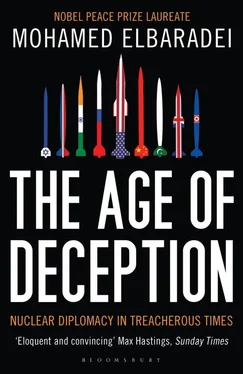In the interim, during a meeting in Washington with Colin Powell and Richard Armitage, deputy secretary of state, I told them that their policy on Iran—with its heavy reliance on sanctions and a boycott to prevent weapons development—was not working. I believed that punitive actions, actions that failed to address the underlying reasons for a country’s pursuit of nuclear development, did not constitute a policy—nor, in any pragmatic sense, a strategy—and would at most delay a nuclear weapons program. If a country like Iran wanted to acquire nuclear weapons, the U.S. approach would not be enough to stop it. Powell did not comment, but Armitage agreed, which I took as a hopeful sign.
At the time, I was drawing on the IAEA’s experiences with Argentina, Brazil, and South Africa. Despite years of restrictions on exports to these countries, the first two had acquired the nuclear know-how for the fuel cycle, and the third had actually acquired (and later relinquished) nuclear weapons. [2] In each of these three cases, the nuclear program was developed before the country was a party to the NPT.
From what we had repeatedly observed, a policy of isolation and sanctions only served to stimulate a country’s sense of national pride; in the worst case, it could make the targeted country’s nuclear project a matter of national priority.
When at last the Iranians settled on a visit during the third week of February 2003, the timing was anything but ideal. North Korea had just withdrawn from the NPT. The UN Security Council was sharply divided over the use of force in Iraq, and a military invasion seemed imminent. Our inspection staff was, to say the least, stretched.
But we needed answers about Natanz. I accepted the invitation and asked Pierre Goldschmidt, the Belgian nuclear scientist who served as my deputy director general for safeguards, to accompany me, as well as Olli Heinonen.
At the opening meeting in Tehran, Aghazadeh and his AEOI colleagues admitted immediately that the facility under construction at Natanz was a large uranium enrichment plant. They insisted, however, that they had not meant to hide it from the Agency. [3] Given the size of the Natanz facility, it is likely that the Iranians were not intending to “hide” it per se. Their aim, I believe, was to delay its reporting as far as legally permissible under their safeguards agreement and to delay IAEA inspection until they had completed their construction and received all the needed knowledge and technology, which were being obtained through clandestine channels due to sanctions. I was later told they were worried that declaring the Natanz facilities would expose their supply network.
Based on their safeguards agreement, they noted, they had no legal obligation to inform the IAEA until 180 days before the introduction of nuclear material. And on this point, they assured us, the record was clean: no nuclear material had been used, and no enrichment had taken place at the facility.
The next day we headed to Natanz, a small mountain town noted for its orchards and nestled among scattered religious shrines. Aghazadeh and his deputy, Mohammad Saeedi, were our escorts, along with a cluster of Iranian engineers and technicians. Our first stop was a nondescript sand-colored building that looked like a warehouse from the outside. Inside was a large hall divided into six concrete blocks. This, Aghazadeh announced, was a pilot enrichment facility. Roughly 20 centrifuges had been assembled. Each block would eventually house a cascade of 164 centrifuges, for a total of slightly fewer than 1,000.
Then we headed underground. Even with some foreknowledge of what to expect, we found the cavernous main hall stunning. It was completely empty but built to house more than fifty thousand centrifuges—a far more ambitious project. Aghazadeh and his colleagues were positively chatty, proud to show us around, agreeably answering the technical questions posed by Pierre and Olli.
Two aspects of that visit stood out. The first was the scale of Iran’s nuclear ambitions, which required a sharp reassessment on our part. Up to this point, the hallmark of Iran’s nuclear program had been one power reactor under construction at Bushehr, for which Russia had contracted to supply the enriched uranium fuel. [4] For a decade, the United States had tried its level best, making demarches around the world, to dissuade the Russians from supplying Iran with the Bushehr reactor. The argument was that if the Iranians were to acquire a power plant, they would have a pretext for also developing fuel cycle capabilities. But the United States was not successful.
But Natanz, when fully operational, would have the capacity to supply the fuel for two or three one-thousand megawatt reactors. What other facilities was the AEOI planning or constructing?
The second aspect was still more disconcerting. Aghazadeh told us that Iran’s centrifuge development program was entirely indigenous. The Iranians also insisted they had not used any nuclear material in testing at this site or anywhere else. Our experts were skeptical.
This skepticism was only reinforced by my meeting with the president of Iran, Sayyid Mohammad Khatami. Charming and multilingual, Khatami, a cleric and former head of Iran’s National Library, had swept to power in 1997, running on a platform of social reform. Domestically he advocated freedom of expression and supported the empowerment of civil society, and he was known internationally for his advocacy of a “Dialogue Among Civilizations.” While he had not achieved all of the promised reforms, Khatami remained popular among moderates and particularly among the Iranian youth, who came to refer to him as “The Man with the Chocolate Robe,” for the brown clothes he favored.
At our meeting, Khatami was accompanied only by Ali Akbar Salehi, [5] Salehi would later succeed Aghazadeh as the head of AEOI and vice president of Iran, and was subsequently appointed foreign minister.
the Iranian ambassador to the IAEA, who acted as a translator. Khatami greeted me warmly, with the traditional kiss on both cheeks. As a cleric trained in the Quran, Khatami spoke Arabic, which he did for a few minutes before shifting into Farsi, with Salehi translating. “You shouldn’t worry at all about our program,” Khatami said. “We only used inert gas in running our centrifuge cascade.”
The detail in the statement struck me as odd. President Khatami, a cleric by training, had just referred to a means of cold testing a centrifuge without using nuclear material. His point was that Iran had not violated any nuclear material reporting requirements. But why would Khatami know about testing with inert gas? I wondered.
In the months that followed, the IAEA began to uncover some answers.
Intelligence information alerted us to the Kalaye Electric Company, a workshop on the southern outskirts of Tehran where the Iranians had tested a small number of centrifuges of the same model as those at Natanz. Kalaye was not a declared nuclear workshop. Our Iranian counterparts assured us that only “simulation studies” had taken place there and that no nuclear material had been used in these simulations. If this was true, then they were within their rights not to have reported it to the IAEA. But how could we be certain if we were not permitted to verify their assertion? We were caught in the classic catch-22 of the NPT: the Iranians had not declared the Kalaye Electric Company in their safeguards agreements, therefore we were not authorized to inspect it, absent some clear nexus to nuclear material. This was the primary loophole that had led to the invention of the Additional Protocol, but Iran had not signed on to the Protocol.
We decided to call Iran’s bluff. Noting Tehran’s public and private commitments to full transparency in its dealings with the IAEA, we asked the Iranians to allow us to visit Kalaye. We also asked for permission to take environmental samples.
Читать дальше












